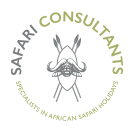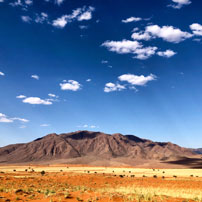 Namibia is a vastly different country to the rest of East and Southern Africa. So much so that I did not appreciate the amazing adventure I was about to embark on as our flight took off from a dark and cold London Heathrow.
Namibia is a vastly different country to the rest of East and Southern Africa. So much so that I did not appreciate the amazing adventure I was about to embark on as our flight took off from a dark and cold London Heathrow.
Namibia is a huge country (three and half times the size of the UK) with a tiny population (26 times less than the UK!) and the sense of space is truly astonishing – it is a country that has the ability to make you appreciate how very small we are.
We began our trip with a night in Windhoek and had a delicious steak and beer at the vibrant Joe’s Beer House. It has such a fun feel to it with locals, tourists, backpackers and overlanders all mixing together and creating an atmosphere of excitement – people buzzing either at the beginning or the end of their adventures around Namibia. It’s well worth a visit if you have a night in Windhoek.
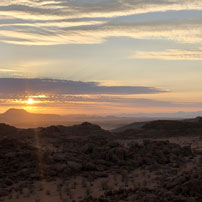
On our first day, we took to the (quite literally) wide open road and began our journey, making our way down south to the beautiful Namib Rand Reserve and the Wolwedans concession. The golden sunshine and the bright orangey red hues of the desert sand make for a truly breath-taking location. We stayed at the tented Dune Camp and had a look round the Lodge. On our second day, we travelled even further south in the reserve to the wild and fantastic Boulders Camp – with a more exclusive and remote feeling and a totally different landscape, even to the north of the reserve, Boulders Camp is worth the extra journey.
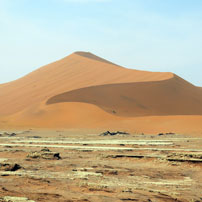 After Wolwedans, we made our way a few hours north to the iconic Sossusvlei Dunes. We spent two nights in the area and split up so we could experience more lodges. Michele spent her first night in Sossus Dune Lodge which is located in the national park and gives you the advantage of being the very first people on the Dunes as the sun rises. I however stayed at the lovely Hoodia Desert Lodge, about 30 minutes’ drive from the park gate. Hoodia was a fantastic experience – Thomas the owner charmed all the guests and the food was delicious. Hoodia arrange an amazing sundowner set up for their guests. You are driven up to a beautiful elevated location where they provide you with drinks of your choice, an amazing array of snacks and leave you to enjoy the incredible sunset and the every changing colours in the sky. I was on my own and was a little daunted when I was told the guide would be back to get me in 1.5 hours but it flew by! I had delicious gin, made locally in Swakopmund, no one to judge how many snacks I had and could soak up the incredible silence and amazing landscape that was in front of me. My solo sundowners was a real highlight of the trip!
After Wolwedans, we made our way a few hours north to the iconic Sossusvlei Dunes. We spent two nights in the area and split up so we could experience more lodges. Michele spent her first night in Sossus Dune Lodge which is located in the national park and gives you the advantage of being the very first people on the Dunes as the sun rises. I however stayed at the lovely Hoodia Desert Lodge, about 30 minutes’ drive from the park gate. Hoodia was a fantastic experience – Thomas the owner charmed all the guests and the food was delicious. Hoodia arrange an amazing sundowner set up for their guests. You are driven up to a beautiful elevated location where they provide you with drinks of your choice, an amazing array of snacks and leave you to enjoy the incredible sunset and the every changing colours in the sky. I was on my own and was a little daunted when I was told the guide would be back to get me in 1.5 hours but it flew by! I had delicious gin, made locally in Swakopmund, no one to judge how many snacks I had and could soak up the incredible silence and amazing landscape that was in front of me. My solo sundowners was a real highlight of the trip!
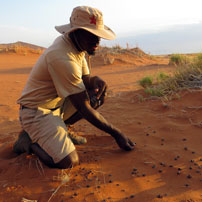 A key reason to stay at Hoodia is the way they operate their Sossusvlei Excursion. The dunes are obviously a big attraction and they do get busy with tourists. Hoodia makes a concerted effort to avoid the crowds and offer an exclusive dunes experience. Instead of racing to the dunes in the morning with everyone else, our guide stopped the vehicle and took us into the desert. We wandered through the sand as he identified the wealth of footprints. We came across a beautiful dune lark, he somehow spotted the web of a dancing white lady spider and managed to catch the spider in his hands and we even got a historical and political overview of Namibia, complete with maps drawn in the sand. It was a really interesting start to the morning and gave us an appreciation of the desert we were standing on. We then made our way to the massive Big Daddy Dune and Dead Vlei, a vast clay pan covered with dead trees, blackened and scorched in the dry heat. While everyone headed off into the dunes on the main pathway, our guide led us towards the “Hoodia Dune.” We climbed up and up, stopping
A key reason to stay at Hoodia is the way they operate their Sossusvlei Excursion. The dunes are obviously a big attraction and they do get busy with tourists. Hoodia makes a concerted effort to avoid the crowds and offer an exclusive dunes experience. Instead of racing to the dunes in the morning with everyone else, our guide stopped the vehicle and took us into the desert. We wandered through the sand as he identified the wealth of footprints. We came across a beautiful dune lark, he somehow spotted the web of a dancing white lady spider and managed to catch the spider in his hands and we even got a historical and political overview of Namibia, complete with maps drawn in the sand. It was a really interesting start to the morning and gave us an appreciation of the desert we were standing on. We then made our way to the massive Big Daddy Dune and Dead Vlei, a vast clay pan covered with dead trees, blackened and scorched in the dry heat. While everyone headed off into the dunes on the main pathway, our guide led us towards the “Hoodia Dune.” We climbed up and up, stopping 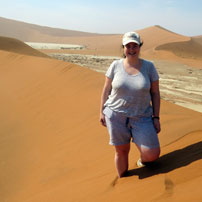 along the way to see the tracks of a sidewinder snake and eventually reached the top with the result of an amazing view over the dunes, Big Daddy Dune in particular and Dead Vlei, with no one else around – a totally exclusive Sossusvlei experience. Of course those who want to brave the trek up the colossal Big Daddy Dune are able to go off and do it themselves, but it was a great experience to go with our guide and get away from the crowds. After our morning’s escapades, we went and set up a lunch table under the shade of a tree, with a few silent oryx nearby. We had cold drinks, delicious food and good conversation to end the adventure.
along the way to see the tracks of a sidewinder snake and eventually reached the top with the result of an amazing view over the dunes, Big Daddy Dune in particular and Dead Vlei, with no one else around – a totally exclusive Sossusvlei experience. Of course those who want to brave the trek up the colossal Big Daddy Dune are able to go off and do it themselves, but it was a great experience to go with our guide and get away from the crowds. After our morning’s escapades, we went and set up a lunch table under the shade of a tree, with a few silent oryx nearby. We had cold drinks, delicious food and good conversation to end the adventure.
After a few more site inspections in the Sossusvlei area, we embarked on the beautiful drive towards the coastal town of Swakopmund. After the heat of the desert in the November summertime, the cool ocean breeze was welcome. Swakopmund is a quaint and charming town and a lovely place to spend a few days. We had an epic day, taking part on a guided trip driving along the wild coastline flanked by incredible sand dunes to reach Sandwich Harbour. The driving was comparable to a roller-coaster at times and there were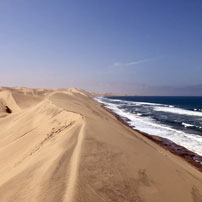 occasions when we were all letting out squeals of excitement as we went up and down the steep dunes – it’s not a gentle drive but it is an exhilarating experience in a stunning and rugged landscape.
occasions when we were all letting out squeals of excitement as we went up and down the steep dunes – it’s not a gentle drive but it is an exhilarating experience in a stunning and rugged landscape.
Following Swakopmund, we drove northwards along the coast towards Henties Bay on a bleak and desolate road, before turning inland towards Damaraland. We spent a night at the fantastic Mowani Mountain Camp. One of the main highlights of the area is to spend a morning searching for the desert adapted elephant. Seeing elephants in a desert environment was a real privilege – the stunning dunes as a backdrop and the relaxed nature of the elephants made it a beautiful experience and an elephant encounter that I won’t forget quickly. Mowani Mountain Camp has a gorgeous location, with an elevated position amongst ochre coloured rocky boulders. They have really made the most of their location and set up a sunset bar on top of the boulders with a view that could rival some of the top sunset spots in Africa. With comfortable beanbags, and some delicious snacks being handed round, it was an extremely pleasant way to spend the evening.
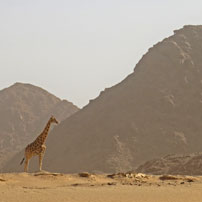 From Mowani, we travelled further north and spent a couple of nights in the Palmwag Concession. One night at Desert Rhino Camp where you can track the elusive black rhino on foot and Etendeka Mountain Camp where walking is the highlight. A lot of time in Namibia is spent driving in a vehicle, so for those who would like the opportunity to break up the driving and stretch ones legs with a bit of walking, Etendeka can offer that. It is a simple camp and you shouldn’t expect luxury or sophisticated service, but you will enjoy good guiding, hearty home-cooked food and a contrasting experience to the rest of your trip.
From Mowani, we travelled further north and spent a couple of nights in the Palmwag Concession. One night at Desert Rhino Camp where you can track the elusive black rhino on foot and Etendeka Mountain Camp where walking is the highlight. A lot of time in Namibia is spent driving in a vehicle, so for those who would like the opportunity to break up the driving and stretch ones legs with a bit of walking, Etendeka can offer that. It is a simple camp and you shouldn’t expect luxury or sophisticated service, but you will enjoy good guiding, hearty home-cooked food and a contrasting experience to the rest of your trip.
Even further north of Palmwag, you start reaching the more remote and less accessible, but stunningly beautiful, Kaokoland. The best way to access this area is to park up your self-drive car and go with a guide. We met Caesar Zandberg from Kunene Safaris at Khowarib Lodge and left civilisation behind for a few days. We drove along the dry river bed of the Hoanib River and watched as the scenery dramatically changed all around us – flanked by mountains, dappled with shade from beautiful big trees and occasionally coming across some desert elephants making their way along the river bed. We spent one 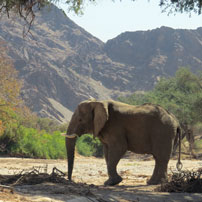 night totally wild camping, in a tributary of the river, nestled into a little crook of the river course and surrounded by huge boulders and mountains. We drank ice cold gin and tonics and sat round a campfire as the meat cooked on the braai and filled the air with delicious smells. Our little dome tents were delightful and beds some of the comfiest we experienced on our whole trip. The only thing that kept me awake at night was the bright full moon, lighting the night’s sky as if someone had forgotten to the lights off.
night totally wild camping, in a tributary of the river, nestled into a little crook of the river course and surrounded by huge boulders and mountains. We drank ice cold gin and tonics and sat round a campfire as the meat cooked on the braai and filled the air with delicious smells. Our little dome tents were delightful and beds some of the comfiest we experienced on our whole trip. The only thing that kept me awake at night was the bright full moon, lighting the night’s sky as if someone had forgotten to the lights off.
Our second night was spent at Purros in a public campsite. It was nice to have a shower and a flushing toilet but it still felt remote enough for those looking for an adventure. We had a gorgeous location looking out over the Hoarusib riverbed and Caesar told us tales 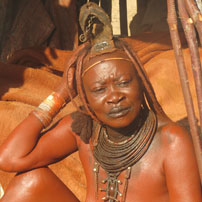 around the campfire of encounters with elephants, lions and driving on steep mountain passes.
around the campfire of encounters with elephants, lions and driving on steep mountain passes.
I can’t recommend a guided safari in this region enough. You do have to be up for some wild camping and comfortable to leave behind a flush toilet and running shower for a few days, but the benefit of seeing this rugged and impressive landscape is undeniable.
Following our wild camping adventures we drove east over the Grootberg Pass towards Etosha National Park. Etosha Pan is the prime game viewing region in Namibia. A huge salt pan of 4,900 km2 makes for an amazing sight and it’s almost incomprehensible in size. The heat results in mirages and it’s hard to tell if you are looking at a lake of water or a salt pan. The grass plains around the pan make for productive game viewing and the game concentrates around a network of waterholes, south of the pan. We spent two nights in the area – the first at Ongava Tented Camp. Ongava is a private concession bordering the national park. The accommodation and overall “bush” experience is far superior (also in cost) to the other accommodation options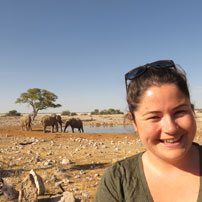 in the area. Ongava offer afternoon game drives on their concession, guided bush walks and morning game drives in the national park. The tented camp has an intimate waterhole right in front of camp so we spent the afternoon photographing a drinking giraffe and the relaxed waterbuck who seemed to call the waterhole their home. The next day, we departed Ongava and drove through the national park calling in at the Namibia Wildlife Resorts (the National Parks body) properties – they offer functional but fairly basic accommodation with the advantage of being located in the heart of the park. As we were travelling at the end of November there had already been some rain which meant that the waterholes were not as productive as they would be in the dry season (June to October), but we still managed to see lion, elephant and big herds of extremely relaxed zebra, oryx and impala. We exited the park on the east side and drove 10km down a tarmacked road to arrive at the Mushara properties. Similarly priced to the NWR properties, but offering a much higher standard of
in the area. Ongava offer afternoon game drives on their concession, guided bush walks and morning game drives in the national park. The tented camp has an intimate waterhole right in front of camp so we spent the afternoon photographing a drinking giraffe and the relaxed waterbuck who seemed to call the waterhole their home. The next day, we departed Ongava and drove through the national park calling in at the Namibia Wildlife Resorts (the National Parks body) properties – they offer functional but fairly basic accommodation with the advantage of being located in the heart of the park. As we were travelling at the end of November there had already been some rain which meant that the waterholes were not as productive as they would be in the dry season (June to October), but we still managed to see lion, elephant and big herds of extremely relaxed zebra, oryx and impala. We exited the park on the east side and drove 10km down a tarmacked road to arrive at the Mushara properties. Similarly priced to the NWR properties, but offering a much higher standard of 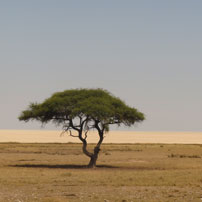 accommodation and service, they are a good alternative. Although they don’t quite offer a “bush experience” like Ongava, they are a fantastic base from which to visit Etosha.
accommodation and service, they are a good alternative. Although they don’t quite offer a “bush experience” like Ongava, they are a fantastic base from which to visit Etosha.
The drive back to Windhoek from Etosha is too far to complete in one day so you need to break the journey somewhere. Often in our itineraries we suggest Okonjima as a good place to do that. It is home to the Africat foundation which works with the local communities of Namibia to educate them about the conservation of the big cats and try and help the human / wildlife conflict that can happen so often in rural Africa. It’s a great place to end the trip and get a bit more of an insight about life in Namibia combined with some excellent game viewing. We ended our trip with an incredible afternoon game drive, with two leopard sightings, an exciting leopard and honey badger interaction, some very 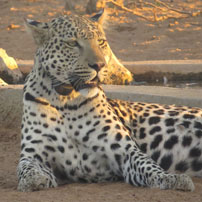 nervous giraffe approaching a waterhole guarded by said leopard and two rhinos, topped off by two aardwolf on our night drive back to camp. What a way to end the trip!
nervous giraffe approaching a waterhole guarded by said leopard and two rhinos, topped off by two aardwolf on our night drive back to camp. What a way to end the trip!
3000km later, armed with many memories, once-in-a-lifetime experiences, adventures and tales to tell, we made it back to Windhoek. Namibia is an astonishing country, so different to the rest of Africa and full to the brim with contrasting experiences. It’s hard to comprehend that in one trip you can be watching the sunset over the golden Namib Rand sand, tracking black rhino among the rocky boulders of Damaraland, watching a huge bull elephant quenching his thirst at waterhole near a massive salt pan, witnessing a bedraggled seal battle against the powerful Atlantic Ocean waves and climbing the red sands of the Sossusvlei Dunes. Self-driving was a thoroughly enjoyable part of the trip and it was satisfying to watch the kilometres clock up as we went and the roads were for the most part very comfortable to drive on. It is also possible to fly around Namibia, especially if you are visiting the more luxury end of the properties, but I do feel that you may miss some of the magic that the country has to offer, the wide open roads and the vast empty landscapes.
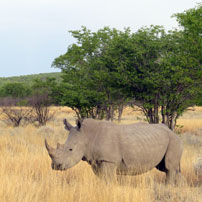 Frances stayed at Olive Grove, Wolwedans Dune Camp, Hoodia Desert Lodge, A Little Sossus Lodge, Desert Breeze Lodge, Villa Margherita, Mowani Mountain Camp, Desert Rhino Camp, Etendeka Mountain Camp, Kunene Safaris, Ongava Tented Camp, Mushara Outpost Lodge and Okonjima Plains Camp,
Frances stayed at Olive Grove, Wolwedans Dune Camp, Hoodia Desert Lodge, A Little Sossus Lodge, Desert Breeze Lodge, Villa Margherita, Mowani Mountain Camp, Desert Rhino Camp, Etendeka Mountain Camp, Kunene Safaris, Ongava Tented Camp, Mushara Outpost Lodge and Okonjima Plains Camp,
Frances site inspected Hotel Heinitzburg, the Hilltop Guest House, the Olive Exclusive, Wolwedans Lodge, Wolwedans Boulders Camp, Sossusvlei Desert Lodge, Desert Homestead, Little Kulala, Kulala Desert Lodge, the Desert Grace, Cornerstone Guesthouse, Brigadoon Guesthouse, The Strand Hotel, the Hansa Hotel, The Delight Hotel, Camp Kipwe, Twyfelfontein Country Lodge, Doro Nawas, Hoanib Valley Camp, Hoanib Skeleton Coast Camp, Okahirongo Elephant Lodge, Khowarib Lodge, Little Ongava, Ongava Lodge, Mushara Lodge, Mushara Bush Camp and Okonjima Bush Camp.
